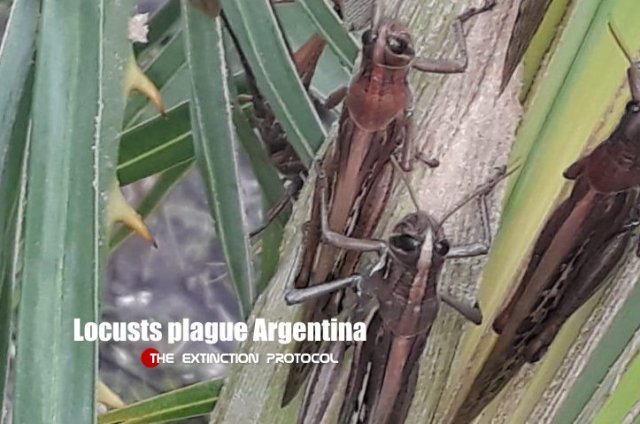15-square-kilometer locust swarm invades Argentina – official says ‘We are following the movement of the plague’

BUENOS AIRES/SAO PAULO (Reuters) – Argentina and Brazil are monitoring the movement of a 15-square-kilometer locust swarm in Argentina’s northeast, though authorities and specialists said so far it had not caused significant damage to crops in the South American countries. Argentine food safety body SENASA said the swarm, which initially entered Argentina from Paraguay in late May, contained about 40 million insects. It is in the province of Corrientes, near borders with Brazil, Uruguay and Paraguay. Argentina and Brazil are among the world’s largest soy and corn exporters. “We are following the movement of the plague,” Héctor Medina, a coordinator at SENASA, told Reuters on Thursday. Due to the arrival of a cold weather front from the south, the movement of the locusts would be limited in the coming days, he added.
 The low temperatures “will prevent them from moving and reproducing. The lethargy makes them stay still,” Medina said. Winds could eventually push the cloud of locusts into a neighboring country, he added. Brazil’s agriculture ministry is also monitoring the swarm and has asked farmers in the south of the country to be on alert, although it has concluded that the locust cloud is unlikely to move into Brazilian territory for now. Nevertheless, Farming Minister Tereza Cristina Dias, declared on Thursday a “phytosanitary emergency” in the states of Río Grande do Sul and Santa Catarina due to the swarm. In Argentina, both SENASA and the Buenos Aires grain exchange said they were less worried by the locust swarm than issues of dry weather impacting crops.
The low temperatures “will prevent them from moving and reproducing. The lethargy makes them stay still,” Medina said. Winds could eventually push the cloud of locusts into a neighboring country, he added. Brazil’s agriculture ministry is also monitoring the swarm and has asked farmers in the south of the country to be on alert, although it has concluded that the locust cloud is unlikely to move into Brazilian territory for now. Nevertheless, Farming Minister Tereza Cristina Dias, declared on Thursday a “phytosanitary emergency” in the states of Río Grande do Sul and Santa Catarina due to the swarm. In Argentina, both SENASA and the Buenos Aires grain exchange said they were less worried by the locust swarm than issues of dry weather impacting crops.
“For now (the swarm) is not a problem, we are more concerned about the humidity issue for wheat planting than locusts,” said Esteban Copati, head of agricultural estimates at the exchange, who added the swarm was moving over a marginal farming area. The pests have raised concerns in Brazil. A representative from the Aprosoja growers’ association in Rio Grande do Sul said they feared the locusts would enter the state where corn is still being harvested and wheat being grown. Eugenio Hack of the Copercampos cooperative in Santa Catarina told Reuters that if the locusts were to move to the state, producers would have to be trained to use the appropriate chemicals, which are different from those normally used. “My grandfather dealt with locusts many years ago. Farmers used to dig ditches in the ground, cover insects with soil, and then set them on fire,” Hack said. –Reuters

Comments
Post a Comment